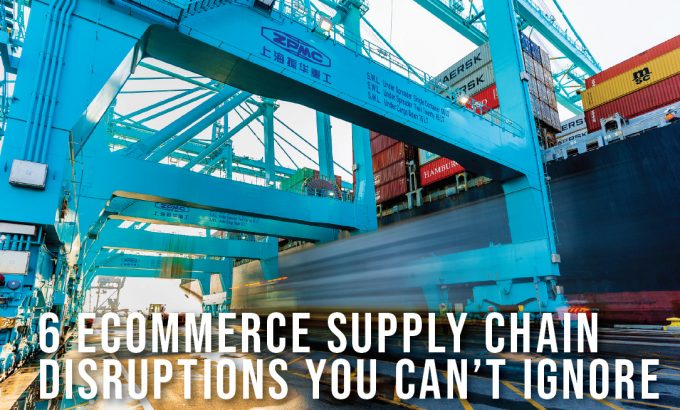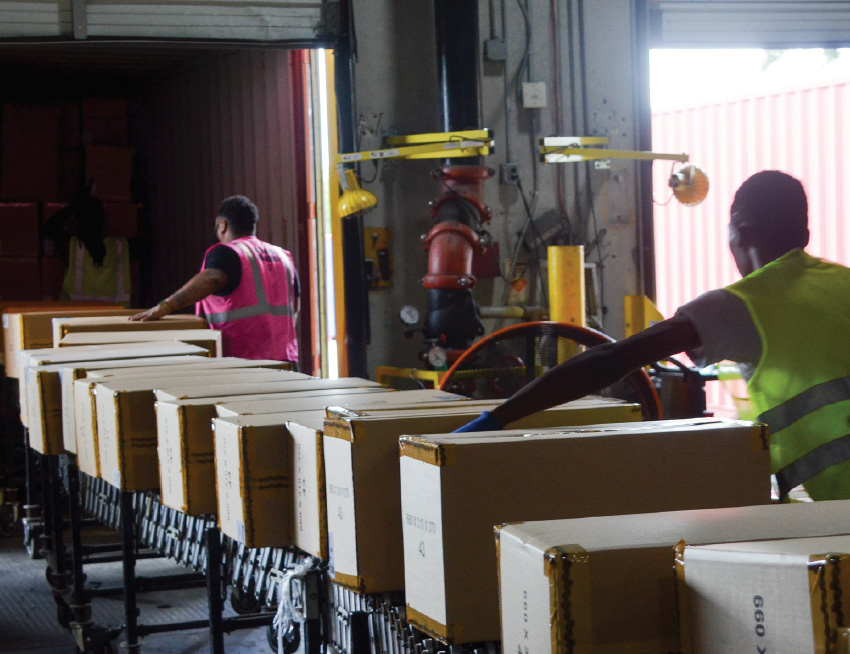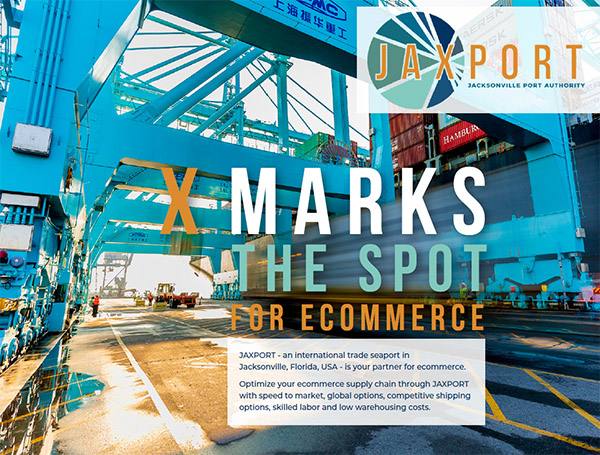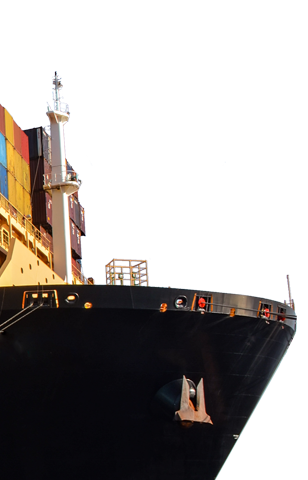6 ecommerce supply chain disruptions you can’t ignore
- Home
- >
- Cargo Blog
- >
- 6 ecommerce supply chain disruptions you can’t ignore

By Conrad Winter
Story first appeared in the 2021 JAXPORT Magazine
In the movie Groundhog Day, Bill Murray plays a TV reporter who is forced to relive the events of a single day over and over and over, finetuning his actions with every iteration until he becomes his best self.
The state of ecommerce supply chains is much the same way today. It was a wild and fast ride before the trade war upped the ante and the pandemic opened the floodgates of demand. Shippers, 3PLs and final-mile delivery providers are figuring it out: developing new best practices and adapting quickly to rise to the occasion.
Frank Camp, Director, Non-Vessel Operations & Container Development at JAXPORT, is at the center of the evolution underway. “The move towards ecommerce has accelerated and it’s only going to increase,” he said. “Once everyone has a chance to collectively catch their breath, you’ll start to see some best practices adopted with regard to ecommerce logistics and maybe even some new changes come into play.”
Consumers are now driving new disruptions—and our demand for free and fast delivery, dependability and easy returns is here to stay. The stars of ecommerce supply chains are the businesses who successfully surmount six distinctive disruptions.
LABOR: A BIG DEMAND FOR HANDS
One of the biggest disruptions caused by ecommerce supply chains is etailers’ need for people to pick products from shelves, pack them and prepare them for delivery to customers.
Camp describes the changes he’s seen at distribution centers (DCs) around JAXPORT. “At a traditional distribution center, the container arrives, the labor in the building strips out the container and puts the goods on shelves where they wait to be shipped out to the store. In an ecommerce building, you’ve got the container coming in and labor stripping it out, putting it on the shelves, and then many, many dozens, if not hundreds of people – depending on the size of the operation – move goods around constantly.”
The demand for hands brings a number of challenges. First is having a labor source that is cost effective and readily available. This is driving many companies to locate DCs near major population centers. A second challenge is ensuring they have adequate staff to meet surges in orders. This pressure drives many companies to partner with 3PLs because it enables them to draw on a steady labor source for ecommerce fulfillment.
“Northeast Florida offers ecommerce shippers a deep and talented workforce – with a labor force more than 845,000 strong,” said Camp.
SPACE: IT’S THE PLACE ECOMMERCE FULFILLMENT OFTEN FALLS SHORT
Ecommerce fulfillment requires more warehouse space than traditional DCs serving wholesale operations. According to Scott Weiss, Vice President of Business Development for Port Logistics Group, a 3PL heavily involved in ecommerce fulfillment, DCs today need more space, not just for pick lines, but also to store products lower so pickers can grab them easily. “We see many importers with their own warehouse and they’re in trouble because they’re full,” he said.
As the size and prevalence of ecommerce supply chains has grown, the demand for warehouse capacity has skyrocketed. In Northeast Florida, more than 6 million square feet of ecommerce leasing has happened over the past three years, according to Jacob Horsley, Senior Director of Cushman & Wakefield.

DC SELECTION: GO WHERE THE CUSTOMER IS
Meeting ecommerce customers’ expectations of free and fast delivery is driving the supply chain disruptions of recent years. The shift from getting goods to stores to getting them to consumers’ homes is directing decisions for where to locate distribution centers for companies like 1A Auto, an entirely ecommercebased auto parts supplier with a large market in the Southeast US. The company decided to open a DC in Jacksonville, Florida to be closer to their customer base.
1A’s Head of Logistics, Richard Higgins explains: “Sixty-four percent of consumers want free shipping and they want same day, next day or second day. In order to do that from a logistics perspective and do it cost-effectively, we need to have facilities that are relatively close to the consumer.
LAST MILE: YOUR SMALL PARCEL PARTNERSHIPS ARE A BIG DEAL
Last mile delivery is a major cost consideration in ecommerce. Etailers’ ability to negotiate rates directly impacts the profitability of their business. That’s because the free delivery customers expect is paid by the seller. Ensuring sort centers are close to the customer base is key to qualifying for low zone rates.
Small parcel rates were a major reason for 1A’s decision to locate a DC in Jacksonville. “By being in Florida and delivering to Florida, we’re going to be zone 2, so we have a massive reduction in what our cost per package is going to be,” Higgins said.
“The customer is going to be extremely happy with the service, and we’re going to be extremely happy with the fact that our cost per package will go down dramatically.”
REVERSE LOGISTICS: DON’T LET RETURNS COME BACK TO HAUNT YOU
Returns used to be easier in brick and mortar retail. Stores would get the products back at the counter, they could be inspected and returned to shelves, and customers would be credited on the spot. Not so in ecommerce – returns are complex, costly and strongly tied to customer satisfaction. “It’s where you can lose a customer for life,” Weiss said.
Today’s consumer expects the returns experience to be as easy as buying online—that means a fast confirmation and credit. That dials up the pressure on etailers. Processing returns efficiently requires additional space and workers as well as communication between different groups who receive returns, check for damage and settle charges. Handling the sheer bulk of returns is the main challenge. Weiss says 30 percent of online purchases are returned. “Many people order two different sizes and then they return the one that doesn’t fit. That’s the hidden cost of ecommerce,” he says.
Etailers typically pay for shipping, but that’s only part of the overall cost of handling returns which can show up in bulk unexpectedly. “You don’t get a notice that it’s coming,” Weiss said. “We have a customer that does 15,000 ecomm orders a day and we could get 4,000 returns that day.”
OCEAN TRANSPORT: E-FRIENDLY PORTS LEAD THE WAY
The disruptions brought by ecommerce supply chains include rethinking ocean strategies. The ideal scenario gets cargo to a DC that is final-mile-shippable to customers. As a result, ecommerce companies like 1A are favoring all-water routes from Asia, through the Panama Canal to ports like JAXPORT. This strategy allows them to set up advantageous DCs close to port and final-mile sort centers that are within striking distance of their largest customer bases.
This turns on its head the long-held assumption that sailing from Asia to Southern California is always fastest. But according to Higgins, the extra week in transit is well worth it. “If you’re buying properly and you’re timing your receipts, it’s significantly more cost effective to utilize the all-water services to the East Coast as opposed to going through the West Coast.”
1A’s planned move to JAXPORT is part of a bigger trend seen by ports like JAXPORT up and down the Eastern seaboard. “This is a totally different supply chain. This is an import distribution to DC right to my front door,” Camp said. “Jacksonville aligns very well with large sort centers and the infrastructure in place to facilitate final delivery more quickly than other ports on the East Coast.”

From startups to large retailers, more and more businesses are choosing JAXPORT to optimize their ecommerce supply chains.
In this 18-page e-book from JAXPORT, learn how Northeast Florida is meeting the industry’s growing demand for industrial real estate space in close proximity to urban population centers.
